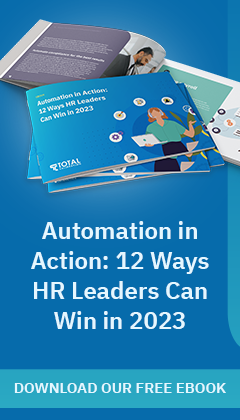Are you tired of spending countless hours on repetitive HR tasks such as data entry and onboarding?
HR automation integrates technology in various HR operations, bringing many benefits to your organisation, including increased productivity, cost savings, and better employee experience. By automating repetitive tasks such as data entry, recruitment, and onboarding, your HR team can focus on strategic tasks that require human expertise, such as talent development and employee engagement.
However, implementing HR automation requires careful planning and execution to succeed. To help you get started, I've put together a 7-step plan to guide you through the process of implementing HR automation tools. By following this plan, you can maximise the benefits of HR automation and improve overall management.
1. Define your HR processes
Effective HR automation requires a thorough understanding of your existing HR processes. Therefore, take the time to assess your current processes before deciding which areas to automate.
Identify the current processes, critically examine the time and resources invested in them, and identify areas you can automate. Mapping out your existing HR processes enables you to identify bottlenecks, inefficient areas and redundancies in the process.
2. Identify automation opportunities
Identifying opportunities for HR automation is the next step. After mapping out your HR processes, look at the tasks you can automate. Look for repetitive, tedious tasks that require significant amounts of manual data entry, scheduling or employee record management.
Identifying areas where automation can improve accuracy and reduce errors is essential to maximising efficiency with HR automation tools. Take the time to carefully evaluate your HR processes and identify the areas where automation will have the most significant impact.
Automating these tasks can improve efficiency, reduce errors and allow HR teams to focus on more critical tasks. Automation can also help to standardise processes across the organisation, ensuring consistency in HR operations.
3. Choose suitable HR automation tools
Selecting the right HR automation platform is crucial in the implementation process. With so many options available, choosing the right platform for your business can be overwhelming. However, by carefully considering a few key factors, you can find the platform that best meets your needs.
When selecting HR automation tools, cost is a critical consideration. Determine how much you're willing to spend and evaluate platforms that fit within your budget. Investing in the right platform can ultimately result in significant cost savings in the long term.
Another crucial consideration is scalability. Choose a platform that can grow with your business and adapt to changing needs. The platform should be flexible enough to accommodate new features and integrations with other HR tools.
Ease of use is also essential to consider when selecting an HR automation platform. Choose a user-friendly platform that HR teams can adopt with minimal training. The platform should have an intuitive interface and be easy to navigate, allowing HR teams to automate tasks quickly.
You should also consider integrations with your existing HR tools. Choose a platform that seamlessly integrates with your current tools, allowing for streamlined and efficient HR operations.
4. Set up and configure the platform
Once you've selected the right HR automation platform, the next step is to set it up and configure it to align with your HR processes. Setting up and configuring the platform can be complex, and allocating enough time and resources to ensure you have set up everything correctly is important. Depending on the platform, this may involve setting up user accounts, configuring workflows, and establishing permissions for different user roles.
It's essential to work closely with your vendor or IT team to ensure the platform is set up correctly and configured to meet your business needs. You must test the platform to ensure all integrations work correctly and that data flows seamlessly between different HR tools.
5. Test the system
Before rolling out the HR automation system to your employees, you must test it thoroughly to identify and address any issues that may arise. Conducting a test run can help you ensure that the system works as expected and that all integrations function correctly.
Testing involves simulating various scenarios to ensure the system can handle different use cases. For example, you could simulate an employee onboarding process or a leave application to test the system's functionality. Testing the system's scalability is essential to ensure it can handle an increasing workload as your business grows.
During the testing phase, involving a diverse group of stakeholders is vital to provide feedback and identify any issues someone may have overlooked during implementation. It's essential to document any problems that arise during testing and work with the vendor or IT team to address them promptly.
6. Train employees
Provide comprehensive training and support to all employees using the new platform. Hold training sessions, create user manuals or tutorials, and provide access to a help desk or support team. It's also important to offer ongoing support and resources to help employees as they become familiar with the new system.
Encourage your team to ask questions and provide feedback throughout the training process. You can leverage this feedback to identify areas to improve the system and clarify confusing or unclear features. Allowing your team to provide feedback can increase their engagement and buy-in to the new system.
In addition to training, it's crucial to communicate the benefits of the new HR automation platform to employees. Highlight how the system will improve HR processes, increase efficiency, and make their jobs easier. This can build excitement and enthusiasm for the new platform and increase adoption rates.
7. Continue improving the platform
Regularly review the system to identify any areas that may require an audit. Conduct consistent audits to ensure the system functions correctly and follows all compliance regulations. Regular reviews and audits will identify potential issues and ensure the system remains efficient.
Based on this, it's essential to continue improving the HR automation platform. You might make changes to the platform and update the processes and tasks.
Continuous improvement is crucial to maximising the benefits of HR automation. Encourage feedback from employees and stakeholders so you can enhance the platform's functionality and improve overall efficiency.
Conclusion
HR automation is essential to modern HR management because it streamlines various processes and enhances overall efficiency. HR automation tools can maximise efficiency, improve HR processes, and reduce the burden of administrative tasks.
Remember, the success of HR automation depends on more than just selecting the right platform. Providing comprehensive training and support, and encouraging feedback and communication, are also crucial to successful implementation. With the right approach, HR automation can significantly improve efficiency, accuracy, and employee engagement.
Total Calibration can implement HR automation tools for your business
Our HR software automates every aspect of the employee lifecycle — without sacrificing quality. We can help you automate recruitment, onboarding, payroll, time and attendance, expense claims, performance reviews, learning management, competency management, offboarding, succession planning and much more. Please visit our HR automation page for more on our capabilities.


